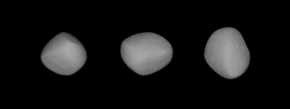679 Pax is a minor planet orbiting the Sun that was discovered by German astronomer August Kopff on January 28, 1909. It is named after Pax, a Roman goddess. It is orbiting the Sun with a period of 4.16 years and an eccentricity of 0.31.
 A three-dimensional model of 679 Pax based on its light curve | |
| Discovery | |
|---|---|
| Discovered by | August Kopff |
| Discovery site | Heidelberg |
| Discovery date | 28 January 1909 |
| Designations | |
| (679) Pax | |
| Pronunciation | /ˈpæks/[1] |
| 1909 FY | |
| Orbital characteristics[2] | |
| Epoch 31 July 2016 (JD 2457600.5) | |
| Uncertainty parameter 0 | |
| Observation arc | 106.90 yr (39044 d) |
| Aphelion | 3.3910 AU (507.29 Gm) |
| Perihelion | 1.7808 AU (266.40 Gm) |
| 2.5859 AU (386.85 Gm) | |
| Eccentricity | 0.31135 |
| 4.16 yr (1518.8 d) | |
| 33.4022° | |
| 0° 14m 13.272s / day | |
| Inclination | 24.387° |
| 112.263° | |
| 266.736° | |
| Physical characteristics | |
| 25.735±1.2 km[2] 32.44 ± 1.82 km[3] | |
| Mass | (7.14 ± 1.99) × 1017 kg[3] |
Mean density | 4.99 ± 1.62 g/cm3[3] |
| 8.452 h (0.3522 d) | |
| 0.1660±0.017 | |
| 9.01 | |
Measurements using the adaptive optics at the W. M. Keck Observatory give a mean diameter of 62 km. This is 16% larger than the diameter estimated using the IRAS observatory. The asteroid is elongated with a size ratio of 1.66 ± 0.23 between the major and minor axes. Photometric measurements reported in 1982 gave a rotation period of 8.452 hours.[4] The asteroid's pole of rotation lies 32° away from the plane of the ecliptic.[5]
Polarimetric study of this asteroid reveals anomalous properties that suggests the regolith consists of a mixture of low and high albedo material. This may have been caused by fragmentation of an asteroid substrate with the spectral properties of CO3/CV3 carbonaceous chondrites.[6]
See also
editReferences
edit- ^ "Pax". Oxford English Dictionary (Online ed.). Oxford University Press. (Subscription or participating institution membership required.)
- ^ a b Yeomans, Donald K., "679 Pax", JPL Small-Body Database Browser, NASA Jet Propulsion Laboratory, retrieved 7 May 2016.
- ^ a b c Carry, B. (December 2012), "Density of asteroids", Planetary and Space Science, vol. 73, pp. 98–118, arXiv:1203.4336, Bibcode:2012P&SS...73...98C, doi:10.1016/j.pss.2012.03.009. See Table 1.
- ^ Marchis, F.; et al. (November 2006), "Shape, size and multiplicity of main-belt asteroids. I. Keck Adaptive Optics survey", Icarus, vol. 185, no. 1, pp. 39–63, Bibcode:2006Icar..185...39M, doi:10.1016/j.icarus.2006.06.001, PMC 2600456, PMID 19081813, retrieved 27 March 2013.
- ^ Marciniak, A.; et al. (May 2011), "Photometry and models of selected main belt asteroids. VIII. Low-pole asteroids", Astronomy & Astrophysics, 529: 14, Bibcode:2011A&A...529A.107M, doi:10.1051/0004-6361/201015365, A107
- ^ Gil-Hutton, R.; et al. (April 2008), "New cases of unusual polarimetric behavior in asteroids", Astronomy and Astrophysics, vol. 482, no. 1, pp. 309–314, Bibcode:2008A&A...482..309G, doi:10.1051/0004-6361:20078965.
External links
edit- 679 Pax at AstDyS-2, Asteroids—Dynamic Site
- 679 Pax at the JPL Small-Body Database